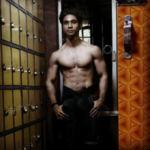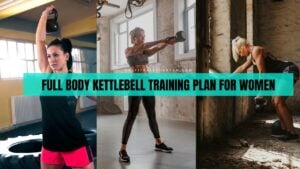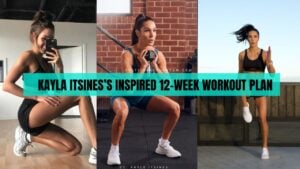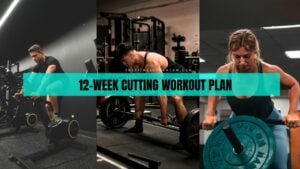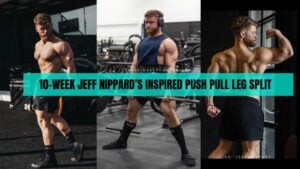Squats are highly effective exercises for developing lower body muscles. Different variations of dumbbell squats maximize the strength and size of your quads, hamstrings, glutes, calves, and hips and help improve functional fitness and athleticism.
In this article, I’ll show sixteen ways to perform dumbbell squats to improve your strength, power, muscle mass, endurance, and balance.
You may already be doing some of them, but learning about them all gives you more options for your different goals.
These squat variations will be helpful to all men and women athletes, bodybuilders, and other fitness enthusiasts.
16 Best Dumbbell Squat Variations to Build Muscle, Strength, and Mobility
- Front Squat
- Split Squat
- Goblet Squat
- Cossack Squat
- Changing Arm Squat Pulses
- Single-arm Suitcase Squat
- Bulgarian Split Squat
- Sumo Squat
- Hack Squat
- Squat Jump
- Squat to Press
- Dumbbell Squat
- Skater Squat
- Squat Clean
- Curtsy Squat
- Pop Squat
You can perform these squats at home or in the gym, wherever you like. All you need is some pairs of light to heavy dumbbells, a workout bench, and a little space.
Those who cannot perform squats with dumbbells can do these bodyweight squats, which help you scale up for the dumbbell squats.
1. Front Squat

About Exercise
- Primary Muscles Worked: Quads
- Other involved Muscles: Glutes and Shoulder
- Exerperice Require: Beginner
- Equipment Needed: Dumbbells Only
- Movement Type: Bilateral
- Force Type: Push
How-to Perform
- Grab a pair of dumbbells with a neutral grip and hold them on your shoulder.
- Keep your feet shoulder-width apart with your toes pointing slightly out.
- Bend at your knees and hips to squat down until your butt is parallel to the floor.
- Maintain a flat back during the entire movement to reduce the stress on the lower back.
Pros
The front dumbbell squat bolsters the quadriceps, helps build solid thighs, and enhances athletic and functional fitness.
Cons
Holding Dumbbells close to your shoulders can put unwanted stress on your wrists and shoulders and limit the load you carry during the squats.
2. Split Squat

About Exercise
- Primary Involved Muscles: Quads and Glutes
- Other Targeted Muscles: Hamstrings
- Exerperice Require: Intermediate
- Equipment Needed: Dumbbells Only
- Movement Type: Unilateral
- Force Type: Push Workout
How-to Perform
- Holding a dumbbell in each hand, stand in the split stance.
- Keep your back upright and your arms straight at your sides.
- Bend your knees to squat down as low as possible and extend your knees until they are straight.
Pros
The split squat, also known as stationary lunges, reinforces multiple muscles simultaneously, including the thighs and glutes, and helps enhance the muscular appearance and overall fitness of the lower body.
Cons
Split squats can be challenging for those whose feet jiggle in the staggered stance. They can also cause knee pain if your knees pass your toes during the movement.
3. Goblet Squat

About Exercise
- Primary Target Muscle: Quads
- Other Involved Muscles: Glutes Maximus and Arms
- Exerperice Require: Beginner
- Equipment Needed: One Dumbbell Only
- Movement Type: Bilateral
- Force Type: Push
How-to Perform
- Hold a dumbbell in front of your chest with bent arms.
- Stand upright in the shoulder-width stance with your feet slightly pointing out.
- Slowly squat down until your glute is close to the floor, pause for a moment, and return to the standing position. Make sure your back remains flat and your knees don’t cross your toes during the movement.
Pros
The goblet squat is another quad-dominant dumbbell squat variation that helps build beefy and defined anterior thighs.
The weight’s position allows for a deeper squat, helping you enhance your balance and flexibility. The best thing is that you can do it with just one dumbbell.
Cons
The Goblet squat involves lifting a dumbbell close to your chest with bent arms; this position puts pressure on the arms and can limit the number of reps per set you can perform.
4. Cossack Squat
About Exercise
- Primary Involved Muscle: Adductors and Outer Quads
- Other Targeted Muscles: Glutes and Abdominals
- Exerperice Require: Intermediate
- Equipment Needed: One Dumbbell Only
- Movement Type: Unilateral
- Force Type: Lower Body Pushing Movement
How-to Perform
- Grab one dumbbell in each hand and hold it on your shoulders with your elbows bent.
- Keep your feet slightly out and two times wider than shoulder-width, and stand straight.
- Squat down to your right side and then return to the standing position.
- Now, perform a squat to the left side and extend your knees. That’s your one rep!
Pros
The dumbbell lateral squats target the muscles at a different angle. They work on the inner thighs (adductors) and glutes medius and make your lower strong and look more defined.
Cons
Cossack squats require good mobility and flexibility in the lower body, and they can increase the risk of falls or strain on the knees for people with stability issues.
5. Changing Arm Squat Pulses
About Exercise
- Primary Involved Muscle: Quads
- Other Targeted Muscles: Glutes and Abs
- Exerperice Require: Intermediate
- Equipment Needed: One Dumbbell Only
- Movement Type: Bilateral
- Force Type: Push
How-to Perform
- Grab a dumbbell in your right hand and stand in the shoulder-width stance.
- Keep your arms straight between your legs and maintain a flat back.
- Lower into a squat until your thighs are parallel to the floor.
- Pressing your feet onto the floor slightly extends your knees (but do stand up back).
- Grab the dumbbell in the left hand and perform lower into the squat again.
- Continue performing the squats in that way for the desired repetitions.
- Your legs will be under constant tension throughout the movement.
Pros
The dumbbell squat pulses maximize growth by keeping your muscles under constant tension throughout the movement.
It also is a high-intensity exercise, helping you torch considerable calories and improve endurance and speed, and elevate your cardiovascular fitness.
Cons
Staying low throughout the movement can put more stress on the lower spine. There’s also a risk of falling the dumbbell on your feet while switching it from one arm to another.
6. Single-arm Suitcase Squat
About Exercise
- Primary Involved Muscle: Quads
- Other Targeted Muscles: Glutes
- Exerperice Require: Beginner
- Equipment Needed: Single Dumbbell
- Movement Type: Bilateral
- Force Type: Push
How-to Perform
- Holding a dumbbell in your right hand, stand in the hip-width stance with your right arm straight by your side.
- Keep your left arm straight out and lower into a squat as deep as possible.
- Pause for a moment, then return to the start.
- Perform 10-12 squats, then repeat on the opposite side.
Pros
The one-arm suitcase squat allows you to work on each leg individually and helps you build a balanced lower body. Going deep during this squat will also help you strengthen the buttocks.
Cons
You won’t be able to lift heavy during the single-arm suitcase squat, and if you do it, there’s a risk of falling or injuring your knees.
7. Bulgarian Split Squat

About Exercise
- Primary Muscles Worked: Quads
- Other Targeted Muscles: Glutes and Hamstrings
- Exerperice Require: Advanced
- Equipment Needed: Dumbbells Only
- Movement Type: Unilateral
- Force Type: Knee Extension
How-to Perform
- Grab one dumbbell in each hand, keep your arms straight at your sides, and place the top of your rear foot on a bench behind you. That’s the start.
- Keep your back straight and chest up, and bend your knees so your rear foot comes close to the ground and your front thigh is parallel to the floor.
- Now, pushing through your feet into the floor, return to the starting position.
Pros
The Bulgarian split squat involves training one leg at a time, helping you focus more on weaker legs and even out strength imbalance. It bolsters quads and glutes, improves hip mobility, and makes your lower body functional and aesthetic.
Cons
Bulgarian split squats are difficult to perform, even for intermediates. It involves holding one leg on the bench behind you while keeping the other one on the ground, requiring decent balance and stability in your lower body.
8. Dumbbell Sumo Squat

About Exercise
- Primary Muscles Worked: Adductors and Glutes
- Other Targeted Muscles: Quads and Hamstring
- Exerperice Require: Beginner
- Equipment Needed: Dumbbell Only
- Movement Type: Bilateral
- Force Type: Push
How-to Perform
- Stand upright with your feet two times wider than shoulder-width apart.
- Keep your toes pointing outward, and grab the end of a dumbbell with your hands.
- Perform a squat until your buttock is close to the floor.
- Pause for a moment and then return to the start.
Pros
The sumo squat is a single-dumbbell squat that reinforces inner thighs, lateral quads, and gluteal muscles from a different angle and makes your lower body look muscular and proportional.
Cons
The external rotation of the hips during sumo squats puts significant stress on the hip joints and groin area, making it uncomfortable for people with poor flexibility. It also requires good balance and stability, especially when using heavier weights.
9. Dumbbell Hack Squat
About Exercise
- Primary Muscles Worked: Front Thigh
- Other Targeted Muscles: Glutes
- Exerperice Require: Intermediate
- Equipment Needed: Dumbbells and Foot Platform
- Movement Type: Bilateral
- Force Type: Push
How-to Perform
- Hold one dumbbell in each hand and keep your arms straight at your sides.
- Place your heels on the foot platform and stand on it. Your toes will stay grounded.
- Keeping your torso upright, bend your knees forward as you squat down.
- Go as low as possible until you maintain your balance.
- Push your feet onto the floor to extend your knees until you’re upright. That’s one rep.
Pros
The hack squat involves keeping your heels elevated on the foot platform and holding dumbbells at your sides, like suitcases. The position of this exercise engages the quad muscles from a different angle and improves balance and muscle coordination.
Additionally, keeping your heels elevated can also improve joint mobility and flexibility, particularly in the ankles.
Cons
The hack squat involves taking your knees beyond your toe line, making it challenging for people with poor hip mobility and knee issues.
10. Dumbbell Squat Jump
About Exercise
- Primary Muscles Worked: Quadriceps
- Other Targeted Muscles: Glutes, Shoulders, Abs, and Arms
- Exerperice Require: Intermediate
- Equipment Needed: Dumbbells Only
- Movement Type: Bilateral
- Force Type: Push and Jump
How-to Perform
- Holding a pair of dumbbells at your sides, stand upright in the shoulder-width stance.
- Perform a half squat and, while returning, jump as high as possible in an explosive way.
- Land your feet softly into a semi-squat position and continue performing it for the suggested reps.
Pros
The dumbbell squat jump is a combination of strength and plyometric exercise. It helps you torch considerable calories, sculpt lower body muscles, and improve your aerobic and anaerobic fitness simultaneously.
Cons
Jumping explosively and then landing with weights can put additional stress on your knee joints, making it harder for everyone, especially for overweight and obese people.
11. Dumbbell Squat to Press
About Exercise
- Primary Muscles Worked: Quads and Shoulder
- Other Targeted Muscles: Abdominals
- Exerperice Require: Advanced
- Equipment Needed: Dumbbells Only
- Movement Type: Bilateral
- Force Type: Compound Push Exercise
How-to Perform
- Grab a pair of dumbbells with a neutral grip and hold them just above your shoulders.
- Perform a standard squat, and as you return to the standing position, press the dumbbells overhead until your arms are straight.
- Return the dumbbells and then repeat the same steps for the next repetitions.
Pros
The squat-to-press is a functional exercise that works on various muscles throughout the body, particularly the legs and shoulders.
It also destroys more calories than isolated exercises, improves cardiovascular health, increases power and explosiveness, and helps level up your overall fitness.
Cons
It combines two exercises – squat and overhead press- making it difficult for newbies.
This exercise isn’t for someone who primarily wants to reinforce their legs and glutes and build burly legs; rather, it improves functional and athletic fitness.
12. Overhead Dumbbell Squat
About Exercise
- Primary Muscles Worked: Quad and Shoulders
- Other Involved Muscles: Glutes and Core
- Exerperice Require: Intermediate
- Equipment Needed: Dumbbells Only
- Movement Type: Bilateral
- Force Type: Pushing Workout
How-to Perform
- Grab one dumbbell in each hand and hold it over your head with straight arms.
- Keep your feet hip-width apart with your toes pointing slightly outward.
- Brace your core and lower into a deep squat, and then return to the starting position.
- Keep your arms straight overhead throughout the movement.
Pros
The overhead dumbbell squat increases the ability to hold the weight overhead for a longer duration, builds strong legs and shoulders, and promotes muscularity and functional fitness.
It also keeps your core engaged throughout the movement and helps build firm abs.
Cons
Individuals with limited shoulder mobility may struggle to maintain the overhead position comfortably, which can lead to injuries. Additionally, the weight you can lift with overhead squats is often lower compared to traditional squats.
13. Dumbbell Skater Squat
About Exercise
- Primary Muscles Worked: Quads and Glutes
- Other Involved Muscles: Hamstrings, Shoulder, and Abs
- Exerperice Require: Advanced
- Equipment Needed: Dumbbells Only
- Movement Type: Single-leg Strength and Mobility Exercise
- Force Type: Push
How-to Perform
- Holding one dumbbell in each hand at your sides, stand upright with your feet together.
- Bend your right knee so the foot is behind you. That’s the start.
- Moving your right leg behind, lean forward slightly, lower into a squat position, and raise the dumbbells in front of you simultaneously.
- Driving through your heel, return to the start.
- Keep your spine neutral and go as deep as possible during the movement.
Pros
The skater squat is a popular but advanced squat variation that involves training one leg at a time. It is excellent for developing strong legs, symmetrical quads, and better stability.
The unilateral nature of this exercise also allows you to work more on your underdeveloped legs and helps you even out muscle imbalances in them.
Cons
The skater squat is an advanced unilateral movement that requires better balance, flexibility, and strength in the lower body and abdominals. This makes it challenging to lift heavy weights or do higher reps. The exercise also puts additional demands on your knees, as your entire body weight relies on a single leg throughout the ascent and descent.
14. Dumbbell Squat Clean
About Exercise
- Primary Muscles Worked: Quads and Shoulder
- Other involved Muscles: Glutes and Abs
- Exerperice Require: Intermediate
- Equipment Needed: Dumbbells Only
- Movement Type: Bilateral
- Force Type: Pull-Push
How-to Perform
- Holding a dumbbell in each hand, stand in a shoulder-width stance with your toes pointing slightly out.
- Pushing your hips back, lean forward, and bend your knees to squat down.
- Driving through your heels and exploding up while shrugging the dumbbells to catch them on your shoulders.
- Extend your hips and knees to return to the standing position.
- Now press the dumbbells overhead until your arms are fully extended.
- Try to perform this exercise as fast as possible.
Pros
Try the dumbbell squat clean thruster if you want to build strength, speed, and muscle. This high-intensity movement works on various muscles at once, such as quads, legs, glutes, and core, and provides a total-body workout.
It also burns many calories quickly, increases strength and explosiveness, and enhances your athleticism.
Cons
The squat clean involves quickly catching the dumbbells on your shoulders that requires good wrist and shoulder mobility, making it challenging for beginners and people with poor mobility.
15. Dumbbell Curtsy Squat
About Exercise
- Primary Muscles Worked: Thighs and Glutes
- Other involved Muscles: Abdominals
- Exerperice Require: Intermediate
- Equipment Needed: Single Dumbbell Only
- Movement Type: Unilateral
- Force Type: Push
How-to Perform
- Holding a dumbbell close to your chest, stand upright with your feet hip-width apart.
- As you lower your body, lift your right foot off the floor and cross it behind your left leg.
- Slowly bend your knee to squat down until your hip is in a normal squat position.
- Drive through your left foot to return to the start.
- Perform an equal number of sets and reps on both sides.
Pros
The curtsy squat targets both the inner and outer thigh muscles and helps build proportional legs. It also strengthens and tones the glutes, contributing to a firmer and shapelier lower body.
Cons
The curtsy squat involves taking one leg behind another in descent, so I recommend avoiding it if you have stiff ankles, knees, hips, or back because doing this exercise incorrectly can cause excessive strain on your knee and tear its ligaments.
16. Dumbbell Pop Squat
About Exercise
- Primary Muscles Worked: Glutes and Adductors
- Other Involved Muscles: Glutes
- Exerperice Require: Beginner
- Equipment Needed: Dumbbells Only
- Movement Type: Bilateral
- Force Type: Jump
How-to Perform
- Holding a pair of dumbbells in front of your chest, stand upright with your feet wider than shoulder-width apart and the toes slightly pointed out.
- Perform a normal squat.
- Jump high and bring your feet in and together simultaneously to stand upright.
- Now, jump your legs out, lower your body into a squat position, and repeat for the desired number of times.
Pros
The pop squat is a high-intensity exercise that helps you build speed, strength, endurance, and power. It works on all the muscles, including the inner thighs and glutes, and helps take your fitness to the next level.
Cons
Jumping explosively and then landing with weights can put strain on your knee joints, making it unsuitable for obese and people with joint issues.
How to Design a Dumbbell Squat Workout Plan
You’ve seen the sixteen different variations of dumbbell squats, and each one has a different purpose. Whatever your goal is, you can use them to design an effective workout plan. For example, you can see how I’ve designed four workout samples for different fitness goals:
Workout A – Muscle Building Dumbbell Squat Workout:
- Front Squats (3 sets x 20 reps)
- Split Squat (3 sets x 10 reps on each side)
- Cossack Squat (3 sets x 10 reps per leg)
- Bulgarian Split Squat (3 sets x 10 reps per leg)
Workout B – Fat Burning Dumbbell Squat Workout:
- 10 Changing Arm Squat Pulses (5 reps per arm)
- 10 Squat Jumps
- 10 Squat Clean
- 5 Squat to Press
- 10 Pop Squat
- Perform as many reps as possible in 20-30 minutes.
Workout C – Dumbbell Squat Workout for Balance and Flexibility:
- Bulgarian Split Squat (3 sets x 10 reps per leg)
- Hack Squat (3 sets x 10 reps)
- Overhead Squat (3 sets x 10 reps)
- Skater Squat (3 sets x 5 reps per leg)
- Curtsy Squat (3 sets x 5 reps per leg)
Workout D – Dumbbell Squat Training to Improve Functional Fitness:
- Goblet Squat (3 sets x 10 reps)
- Cossack Squat (3 sets x 5 reps per side)
- Squat to Press (3 sets x 10 reps)
- Squat Clean (3 sets x 10 reps)
- Curtsy Squat (3 sets x 5 reps per leg)
- Jump Squat (3 sets x 10 reps)
Do Dumbbell Squats Build Mass?
Yes, the different variations of dumbbells work on each lower body muscle, from quads and hamstrings to glutes and hips, and help promote hypertrophy. Additionally, they help improve your balance, endurance, and jumping movement.
Can You Squat Every Day?
Yes, you can squat every day. For example, you can do the dumbbell goblet squat, Squat to press, and Bulgarian split squat on Monday; the dumbbell skater squat, curtsy squat, and dumbbell hack squat on Tuesday; and dumbbell jump squat, pop squat, and squat clean thruster on Wednesday and so on. I recommend trying different variations on each day.
Are Dumbbell Squats Bad for Knees?
Dumbbell squats aren’t bad for knees as long as you do them with the correct form.
A study published in the PMC journal invalidated the command suggestion that deep squats could cause an increased injury risk to the lumbar spine and the knee joints and instead suggested that the deep squat can be effective for protection against injuries and strengthening the lower body muscles.1 Hartmann H, Wirth K, Klusemann M. Analysis of the load on the knee joint and vertebral column with changes in squatting depth and weight load. Sports Med. 2013 Oct;43(10):993-1008. doi: 10.1007/s40279-013-0073-6. PMID: 23821469.
Wrapping It Up
The lower body is responsible for every tiny activity you do. From getting out of bed to sitting down in a chair, from picking an object off the floor to running on the track, the quads, glutes, hams, hips, and calves are responsible for almost every move we make. That’s why strengthening these muscles becomes pretty essential.
You can do various exercises to solidify your lower body muscles, but squats are the best of them. The dumbbell squat variations I’ve shared in this article are excellent for all fitness enthusiasts.
Whether you’re a male or female athlete or muscle builder, you can do some of them or all of them to enhance your strength, speed, mobility, and mass.
Moreover, you can combine squats with other lower-body exercises, such as lunges, step-ups, and hip thrusts, to make your lower body strong, flexible, and aesthetics.
References
- 1Hartmann H, Wirth K, Klusemann M. Analysis of the load on the knee joint and vertebral column with changes in squatting depth and weight load. Sports Med. 2013 Oct;43(10):993-1008. doi: 10.1007/s40279-013-0073-6. PMID: 23821469.


